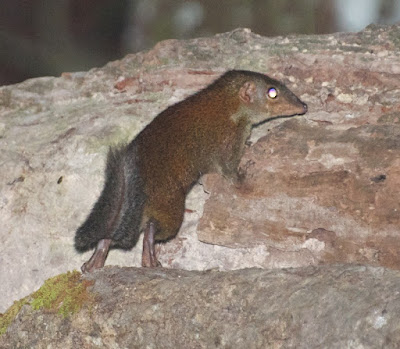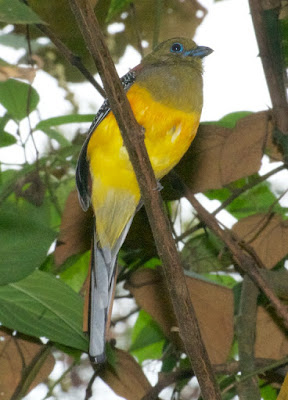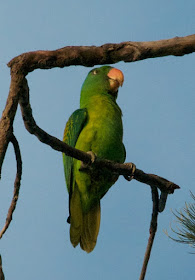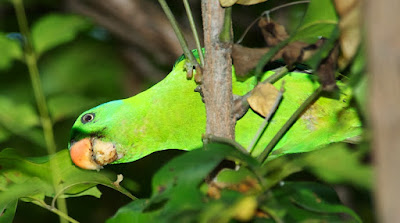Mark and I parked above the Japanese Village (a feature of the mountain) and walked up into the forest...
...until we reached a broad, leafy trail through the trees, where we settled down to watch and wait.
Apparently birds weren't the only animals to associate the arrival of birders with the prospect of largesse (unfortunately for them, we had forgotten to bring anything). This Common Treeshrew (Tupaia glis) ventured out onto the path a few times, probing about on a fallen log (and possible mealworm depository).
Whether this Mugimaki Flycatcher (Ficedula mugimaki) was also looking for a handout I cannot say.
I suspect that this Orange-headed Thrush (Zoothera citrina) was expecting us to provide something. This was a life bird for me so I cannot say much about its typical behaviour, but Zoothera thrushes in general are notorious skulkers. I have never seen one as tame as this.
The longer we sat, in fact, the closer the bird came. I was delighted by this, of course, but surprised all the same - not just because this is a Zoothera, as I mentioned above, but because this is a bird that is particularly popular among bird trappers. In fact, the only ones I had seen before this were in cages in bird markets. Perhaps that sort of trapping isn't going on at Bukit Tinggi, but you'd think that this was one species that would give us a wide berth.
Anyway, I am very glad that this particular bird didn't feel that way. This is a beautiful creature, and (like most other animals) is far lovelier in nature that behind the bars of a cage.
The star attraction, of course, was the Mountain Peacock-Pheasant - one, by the way, of only a handful of birds confined to the Malay Peninsula. Finally, the male strode out of the undergrowth almost at our feet. Clearly he was in search of a handout, and when we didn't provide one he stalked off again before I had a chance to snap more than a couple of quick photos, without flash. Still - what a moment!
After drinking in, however briefly, the pheasant (and, at more leisure, the thrush), we headed back down the hill to what is billed as "the world's first Japanese tea house in tropical forest". Whether or not that's true (and we didn't actually go into the teahouse). It was certainly surrounded by forest, and set in a very attractive garden.
Here, on a slope lined with vine-covered trellises, we were visited by a confiding juvenile Tiger Shrike (Lanius tigrinus).
Perhaps it, too, was looking for a handout - or perhaps it was merely curious about us.
High above us we spotted a Cream-coloured Giant Squirrel (Ratufa affinis), the same species that we see in Borneo (there is another species, the Black Giant Squirrel (R. bicolor), that also occurs on the Peninsula). Note the truly spectacular tail.
Here is the squirrel again, this time on video.
And this peculiar object growing out of (or attached to) a tree trunk overhead. What it is I can't imagine. Is it a fungus? Some sort of insect nest? Any guesses (or, by preference, actual knowledge)?
As we scouted the area, this stockily-built bird of prey flew into the top of a tall tree. With a bit of work, we identified it as a juvenile Rufous-Bellied Eagle (Lophotriorchis kienerii), an uncommon species that I have seen only a few times before.
I'm afraid that, in negotiating for a position to get a good shot, I may have scared it off before Mark could get his own photo - a failure of birding etiquette I still feel badly about.
I'm glad to say, though, that we both had superb look at this Orange-breasted Trogon (Harpactes oreskios). The greenish breast marks it as a female.
From the teahouse we shifted ground to the Tanglir Falls area, where a mountain stream debouches in a series of handsome cascades.
Here we picked up a few common birds, including this Stripe-throated Bulbul (Pycnonotus finlaysoni), photographed out our car window as it sat in a Norfolk Island Pine (Auracaria heterophylla)...
...and a Blue-tailed Bee-eater (Merops philippinus) perched on a thin strand of bamboo.
It was getting a bit warm for birds, though, and my interest in the area (other than scenery) was mostly entomological. Streams like this one are always good places for damselflies: this is a male Neurobasis chinensis.
Rhinocypha (or Aristocypha) fenestrella is common on clear forest streams, but this male was a new one for me.
The only dragonfly I found in the area was this female Rhodothemis rufa.
Butterflies were also in evidence; wet soils near streams are good places to find Common Mapwings (Cyrestis maenalis).
This Common Red Forester (Lethe mekara gopaka), a widespread Southeast Asian butterfly but another new species for me, is a female (the male lacks the white band on the forewing). Why it is called "Red" I cannot imagine; there isn't a jot of red on it. A pretty butterfly, though!































































